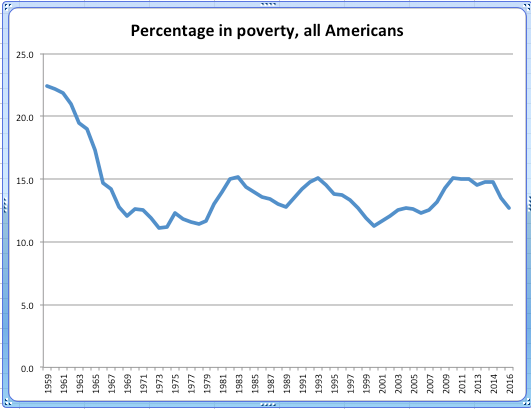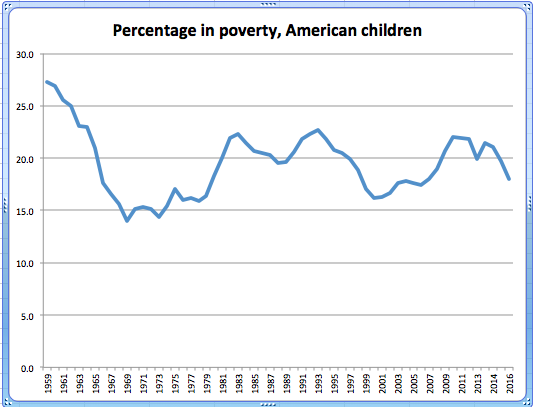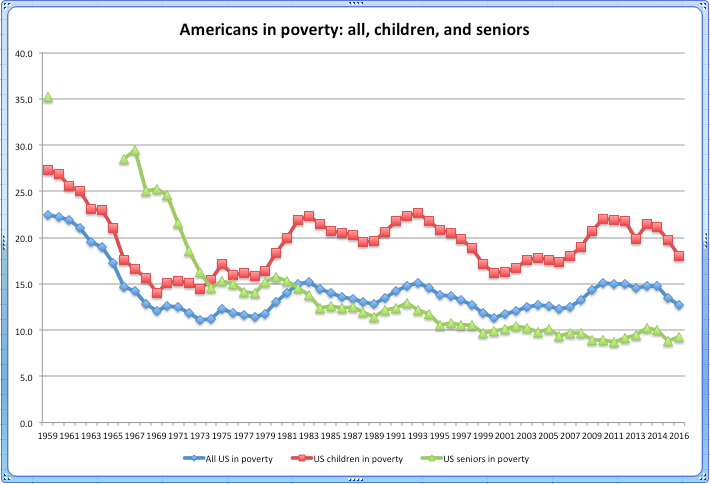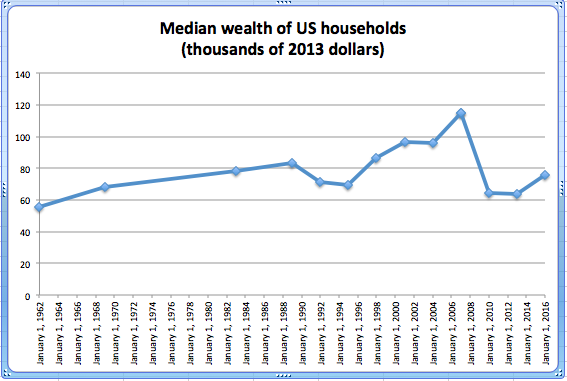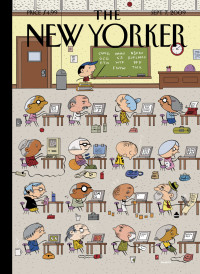After a week of missteps, the Republican National Convention concluded on Thursday night with a speech by Donald Trump that was strong and persuasive. Unusually, for Trump, most of the statements in the speech were actually true. Trump’s character is so flawed that his election would, I think, be devastating; the success of his speech therefore terrifies me.
In this post, I want to revise an earlier post of mine, in which I tried to explain Trump’s appeal and how hard it is for an upper-class liberal to reply to it. I agreed, in that post, with the widespread notion that Trump is channeling the rage of the working class, and the class just above it, about the migration of American jobs to other parts of the world. Like others, I suggested that the rage may be justified even if Trump’s proposals offer no real solution. I wrote that Trump seems to be offering to restore workers’ dignity by arranging for the nation’s borders to do what a union’s picket line used to do—keep out competition that would erode labor’s earning power. At the end of my post, I mentioned, as a caveat to my own argument, that Trump’s proposal wouldn’t work, because a trade war would in fact destroy American jobs, and that American manufacturing, somewhat puzzlingly, is “at an all-time high, if measured in dollars rather than jobs.”
A few weeks later, I un-published my blog post, because it seemed to me that my caveats carried more weight than the post they were attached to. It also seemed to me that in the post I had underestimated the importance of dog-whistled racism to Trump’s appeal. But I’ve now republished that post, with a half-disavowal, and I’m adding this one, because I think it’s worth continuing to try to figure out what’s going on—even if all I really manage to do in this post is think out loud.
From the top, then: Trump’s RNC speech contains two appeals. The first is to fear of violence. As most members of America’s beleaguered fact-based community already know, Trump is exaggerating the dangers posed by civil unrest and terrorism. No policy could guarantee complete safety from either threat, but both are being handled relatively well by ordinary policing. Could they be handled better? Sure. But with the exception of 11 September 2001, terrorism-related deaths of American citizens seem to have been lower this century than they were in the 1990s, and the outcomes of America’s wars in Iraq and Afghanistan hardly suggest that a more militant approach would improve matters. Trump’s fear-mongering has a racist color here, frightening and worth paying full attention to. His demagoguery on this point seems fairly straightforward, however, at least to those willing to see it, and for the rest of this blog post, I want to focus on his second appeal.
That appeal takes the form of a promise to restore earning power to Americans in the working class and the class just above it. Trump claims that he, unlike Clinton, cares about American jobs rather than American money-making, and that he will bring back to America jobs that have been lost through free-trade agreements to foreign manufacturers. He calls Clinton a “puppet” of big business and the moneyed elite, and for his RNC speech, someone on his speechwriting team had the canny idea of reviving a term deployed by Franklin D. Roosevelt during the Great Depression: he called American workers “the forgotten men and women of our country.” This is a remarkable reversal of the historical alliance of the Republican party with business and finance, but then, it probably doesn’t make sense to think of Trump as a Republican. He took over the Republican party the way a parasite might take over its host. He’s a new breed, and he won’t be defeatable by old methods.
In my earlier post, I tried, at the risk of seeming more sympathetic to Trump’s message than I’m entirely comfortable with, to explain why Trump’s message might resonate with people who feel shut out from the prosperity of the last couple of decades. The opportunities for class resentment and misunderstanding here are rich. The meritocratic ethos of America’s elite is galling if you happen to be living beneath it. The gall, to be specific, is in the extra little fillip of hegemony that makes the lives of the rich not only superior in luxury but also, at least seemingly, superior in virtue. Organic milk may be too expensive for your budget, but conventional milk, you’re told, is cruel to cows. You may not be able to afford an apartment close enough to your job to allow you to bike to it, but you nonetheless have to hear that bike lanes are saving the world from climate change. It’s irksome to hear injunctions to save the world if you’re having a hard time just surviving in it. (I write this, please understand, as a vegetarian who buys organic milk and bikes daily. And yes, I know that bikes alone won’t save the world from climate change.) Political correctness begins to seem like another of the elite’s purchases—another display of the ability of the rich to afford nicer things, one of those things being a nicer soul. And there’s a niggling suspicion, in the person who can’t afford the nicer things, that the financiers, lawyers, executives, and consultants who can afford them have drawn much of their wealth, in the last few decades, from offshoring—from the separation of the design, management, and marketing of products from the actual making of them, which has been in many cases shipped abroad.
Trump is saying to his audience, You’re right to be angry; you’re right to feel that it’s unfair; they betrayed you. “America has lost nearly-one third of its manufacturing jobs since 1997,” he said, last Thursday night in Cleveland—a statement that a fact-checker at the Washington Post confirmed with the words, “This is true.” As the Post reported in 2013, America had 17 million manufacturing jobs in the 1990s, and two decades later only had 11.7 million. Though Trump doesn’t mention it, manufacturing jobs seem to pay better than others, making their loss particularly hard.
An economist might reply that jobs are not the same as profits, and that manufacturing is actually doing okay if you count the dollars. Like almost everything else, the real value added by American manufacturing crashed during the Great Recession (2007–2009), but since then it has mostly recovered. Why so few jobs, if the dollars are still coming in? As the Post noted in 2013, “the price of robots relative to the cost of human labor has fallen 40 to 50 percent since 1990, and that trend is expected to continue.” In other words (and this is more or less the official story, according to American manufacturing’s boosters), maybe American manufacturing has gone high-tech and now relies more on mechanization than it used to. Maybe the nature of American manufacturing has changed, nudged by competition with low-wage countries like China, and maybe American manufacturers now simply need fewer workers than previously. After all, classic economic theory predicts that free trade is always in a country’s interest, despite anecdotal evidence to the contrary.
But in a 2015 report titled “The Myth of America’s Manufacturing Renaissance,” the nonpartisan Information Technology Innovation Foundation (ITIF) reported that in fact free trade hasn’t had the beneficial effect on America’s manufacturing sector that classic theory would predict. “U.S. manufacturing lost 11 times more manufacturing jobs in the 2000s than in the 1990s despite similar rates of manufacturing productivity growth in both decades,” the report’s authors write. The acceleration suggests that the loss of jobs can’t be entirely explained by robots. According to another common explanation for job loss in manufacturing, it’s natural, as a nation’s economy matures, for its service sector to grow as its manufacturing sector shrinks. Maybe so, writes the ITIF, but “Consumption of manufactured goods as a share of U.S. GDP, when measured in inflation-adjusted terms, is the same today as it was 40 years ago.” If we’re still paying as much we used to for manufactured goods, that suggests that the economy itself hasn’t altered in a fundamental way; we’re just making fewer manufactured goods than we used to, compared to our trading partners. Just to make sure that their news is perfectly depressing, the ITIF also explains that though there has been a small rebound in manufacturing in the past few years, it has probably been caused by people finally getting around to making purchases that they postponed during the Great Recession. The rebound won’t last.
It’s worth spelling out that the ITIF report doesn’t disprove the official, boosterish narrative about the inevitability of job loss as productivity rises. Of course that’s happening, the report admits. (Though, woe to the politician who tells the people. The disappearance of your job is a sign of American manufacturing’s progress and rising efficiency is probably not something that it is in the interest of any politician in a democracy to say.) It’s just that something else is happening, too, on which a cheerful face cannot be painted.
What is it? It’s probably beyond the capacity of a literary critic moonlighting as a political blogger to give an answer. My suspicion, based on little more than reading the morning paper over the years, would be that in their rush to save money by offshoring, America’s corporate managers inadvertently dispersed centers of expertise, including supply chains, that had long anchored particular manufacturing sectors in the United States—thereby destroying what the Harvard Business Review calls “industrial commons.” No manufacturer can be self-sufficient, especially not a high-tech one; making complicated things well requires a community of other skilled makers. If the only source for needed parts is in Japan, an American automaker may feel obliged to shutter an American factory.
What is to be done? Trump’s proposal to scrap free-trade agreements is unlikely to bring any centers of manufacturing excellence back home. In fact, as the New York Times has reported, Obama actually tried a Trump-style tariff in 2009, slapping a 25 to 35 percent tariff on Chinese tires to protect American tire-makers. Three years later, Obama claimed that he had saved a thousand American jobs, but in the meantime, Americans had spent more than $1 billion more on tires than they otherwise would have, and a retaliatory tariff from China cost America another $1 billion in lost chicken sales. The Los Angeles Times adds, moreover, that as the market adjusted to the tariff, “shipments from South Korea, Thailand and Indonesia doubled in value, more than offsetting the decline in Chinese-made tires,” and that while sales of American-made tires did rise after the tariff, employment in American tire-making “continued a long and steady decline.” Not quite a win-win outcome.
If the American government were to try to nurture a particular industry, in an attempt to restore a manufacturing nexus, the effort might risk being condemned as a subsidy by one of the free-trade organizations that America belongs to. (Industry-specific subsidies are sometimes allowed, but only in developing nations.) And then there’s the danger of betting on the wrong horse; cf. Solyndra.
Economists like to complain that voters fail to understand that free trade is worth the costs. In fact, however, according to the Pew Research Center, a majority of Americans still believe that free trade is on the whole a good thing, 51 percent to 39 percent (though Trump supporters consider free trade a bad thing, 67 percent to 27 percent). And Gallup finds that 58 percent of American adults consider foreign trade an opportunity, and only 34 percent consider it a threat.
To trade freely or not to trade freely . . . It seems to be hard to think outside of this particular box. Trump doesn’t. Sanders doesn’t, either, really: he voted against every free trade agreement that came through the Senate. Clinton voted for some free-trade agreements and against others, depending on her assessment of the protections afforded by each agreement to workers and the environment. That may sound too nuanced for this election cycle, but I have even worse news. I’ve spent a day and a half now puzzling over this blog post, and just now I googled for “Hillary Clinton industrial policy,” to see if she had gone on the record with any ideas. It turns out that there’s a fact sheet on her campaign site, corresponding to a speech she gave in December 2015, that proposes investing in America’s “industrial commons.” I swear I didn’t know this until I reached the paragraph you’re now reading. Her fact sheet is hopelessly nerdy, a bit verbose, and rather bland—not unlike this blog post. But Clinton got there ahead of me. Never let it be said that she doesn’t do her homework.

